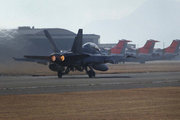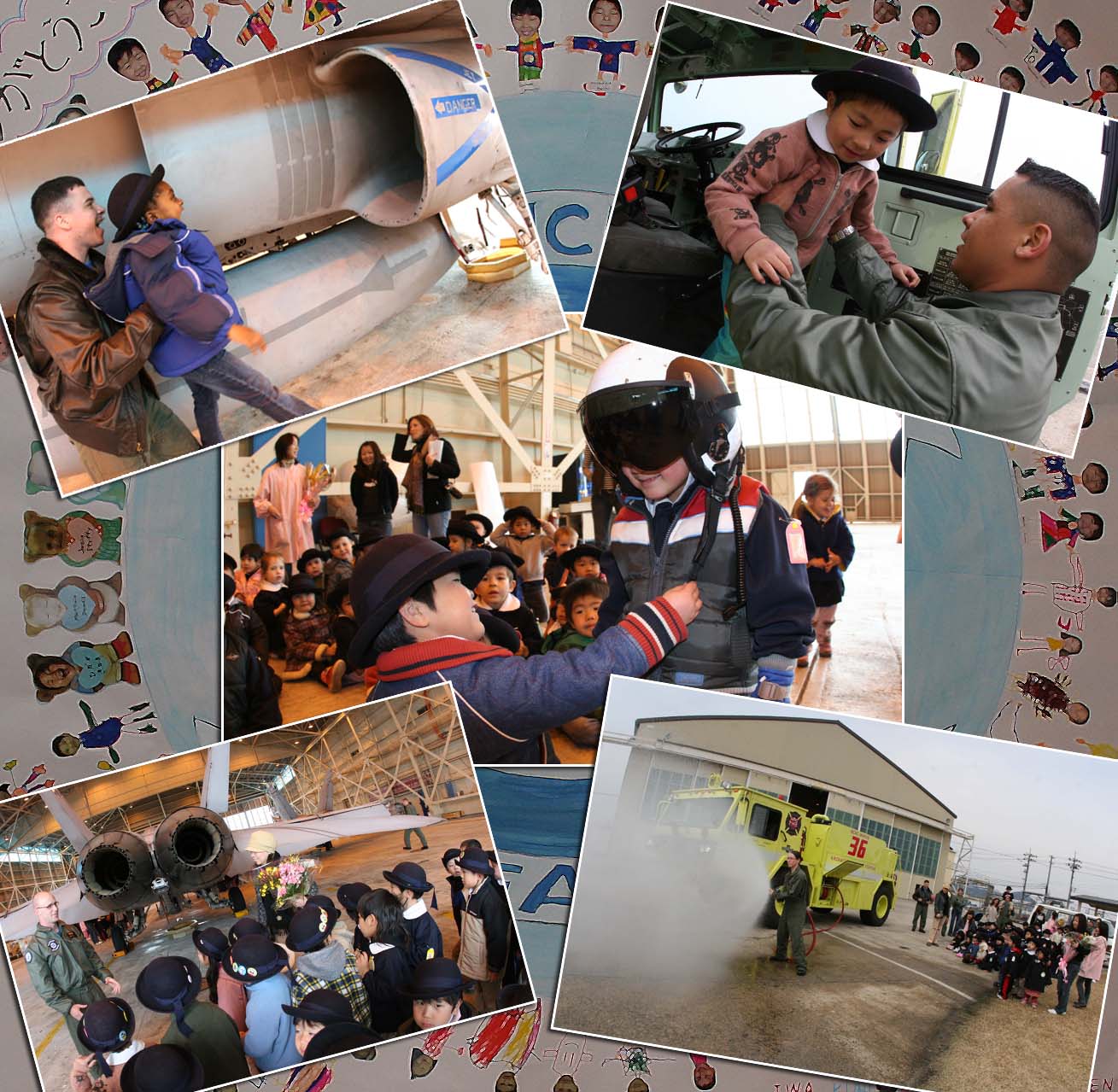David McNeill
Inside the Iwakuni marine base, a slice of Americana: a mess canteen adorned with solemn portraits of former presidents and tributes to fallen US troops in battlefields around the world. TVs mounted on the walls flicker with US sports programming as beefy marines tuck into pasta, tacos and cheesecake.
The sight of American and Japanese soldiers on the same military facility in Hiroshima can be a surprise. This is, after all, just miles from where the Pacific war ended in a nuclear holocaust unleashed from a US bomber that killed 140,000 people.

Iwakuni Marine Air Station Logo
The troops have shared the Iwakuni base for decades as part of a half-century alliance that shelters Japan beneath the world’s largest military and nuclear umbrella. Behind these fences, the two sides salute each other, co-operate in military exercises and swap tactics.
But while US troops get to fire live weapons and drop bombs around the world, Japanese troops must stay at home, tied by constitutional restrictions – ironically written by the Americans during their postwar occupation of the country – that forbid military engagement.
Those restrictions are a hindrance – to the military ambitions of both sides. Iwakuni is the closet military airfield in Japan to the Korean demilitarized zone, and, as it has since the outbreak of the Korean War in 1950, the US wants all the help it can get.
“If anything happens, we will be in the hotspot,” says Master Sergeant Lesli Coakley of the base’s public affairs office. Her Japanese colleague, MDSF Captain Shoji Satoru runs his stick across a map showing Korea, China and Taiwan. “This is the area we have to watch out for,” he says. “Strategically this is the most important base in Northeast Asia.”
Japan’s hog-tied army has given it the reputation of a military minnow, but under US tutelage the country has quietly built up a formidable war machine, with an annual budget of $41 billion. In addition to hosting more than 40,000 American soldiers in 89 bases like Iwakuni, the world’s second-largest economy boasts a self-defense force army of 238,000, among the best-equipped on the planet.

US F-18 takes off from Iwakuni
The 45,000 air self-defense force personnel fly a fleet of about 200 F-15 fighters, one of a handful of militaries, including Saudi Arabia and Israel, allowed to buy them from the US. The country also has 32 F-2 fighters, 109 P-3C long-range aircraft, 16 conventional submarines and four Aegis-equipped destroyers, carrying a price tag of three-quarters-of-a-billion dollars each.
This, in other words, is an army dressed up with nowhere to go. The incongruous ‘defense’ force military hardware on display in Iwakuni includes state-of-the-art electronic firing ranges, flight simulators and a $500 million fleet of 10 Sikorsky helicopters dedicated to sweeping for mines, despite the fact that nobody has planted a mine in a Japanese harbor in decades, nor is anyone likely to. “They’re just in case something happens,” said a Japanese pilot.
The half-century taboo on going to war has kept uniformed Japanese troops mostly out of the sight. “Many Japanese people are unaware of the fact that their country has an army under another name,” writes Richard Tanter, senior research associate at Nautilus Institute for Security and Sustainability, who points out that unlike America, uniformed troops are rarely seen in public here, even in Tokyo.
“For substantial parts of the population, the armed forces of the country are not just unconstitutional, but deeply illegitimate,” he says. The Iwakuni soldiers – Japanese and US – change into civilian clothes when they step off base.
The taboo has prevented Japan from building bombs, bullets and landmines, but it does make ships, submarines and large sections of the thousands of commercial airliners that fly around the world. And as a major nuclear power, all that is standing in the way of an A-bomb is a political decision that is gaining momentum, under Prime Minister Abe Shinzo, in the wake of mounting tensions with North Korea.
Abe has unambiguously declared his intention to scrap the war-renouncing Article 9 of the Constitution, written in 1947 under US occupation. This year, Japan’s Defense Agency was formally upgraded to a ministry, “the most important change in Japan’s national security system since the agency and the Self-Defense Forces (SDF) were established in 1954,” said the Asahi newspaper.
The specter of a remilitarized, aggressive Japanese nationalism is something of a journalistic cliché and is rejected by some who call it a much needed readjustment to the new security ‘realities’ of Asia. Some describe it is merely a great power sloughing off the outdated constitutional shackles of the Cold War and say China, which is not above exaggerating the Japanese threat for its own political ends, is the real menace to the region.
That ignores the tit-for-tat nature of rearmament. Japan’s determination to push a joint missile defense system, which was handed a recent budget increase of 30 percent (to Yen 182.6 billion) has already provoked a warning by Beijing that it could “destroy the balance of international security forces and…cause a new arms race.”
Moreover, the profound, post-1990 reordering of the country’s political and military architecture is built on unsteady foundations. Tokyo has simply not persuaded the rest of Asia that it has truly come to terms with the past. As it moves closer to its American military partner and sheds the decades-old restrictions on military activity, the prospect of a remilitarized Japan fills many neighboring countries with trepidation.
The country’s uneasiness with history is on display in a museum in the nearby maritime base town of Kure, dedicated to the Yamato, the biggest battleship of World War II. The museum is filled with passive expressions like “extension of the battle lines” as though the war, like bad weather, simply descended on the guileless people of Japan instead of being fuelled by disastrous political decisions.
In the Maritime SDF base in Edajima, young military officers graduate as they did 70 years ago under a shower of cherry blossom petals. We are pointed to an ancient cherry blossom tree in the courtyard, the subject of a famous wartime song, Doki No Sakura, sung by doomed kamikaze pilots who are eulogized in an on-base museum.
Inside Edajima and Iwakuni, the young soldiers on both sides have long ago ceased caring about what went on six decades ago. SDF troops walk past portraits of presidents their predecessors would have spat on, and US F/A-18 Hornet pilots wear insignias that mix the once-hated symbol of the Japanese Imperial Army the rising sun – with stars and stripes.
“The war was a long time ago,” says Sgt Coakley. The troops are gearing up for a massive base expansion that will see the number of US aircraft and personnel double (to 6,000 people) and the construction of a $2.5 billion offshore runway, funded by the Japanese taxpayer. Japan already pays for about half the costs of hosting its American guests, or about 230 billion yen a year, according to Tanter.

Elementary school visitors to Iwakuni in March 2007 event
Outside, however, some are reluctant to let go of the past so easily. “There are people who see joint military co-operation as a sign of progress, but not me,” says Nishimura Ayako, who campaigns for the closure of all US bases in Japan. “We are going backwards, not forwards.”
Nishimura has been heartened by a 2006 local referendum in which 89 per cent of local voters opposed the base expansion. But most military commanders around this city, rebuilt from the ruins of a war that happened long ago, believe this is a temporary pothole on the road to a brave new future where American and Japanese troops will finally fight on the same side.
“I want to be able to contribute to international society,” says Japanese chief petty officer Taguchi Osamu. “That’s why I joined the SDF.”
David McNeill writes regularly for the Chronicle of Higher Education, the London Independent and other publications. He is a coordinator of Japan Focus. This is an extended version of an article that was carried in the Irish Times on Feb. 25, 2007. Posted at Japan Focus March 25, 2007.



